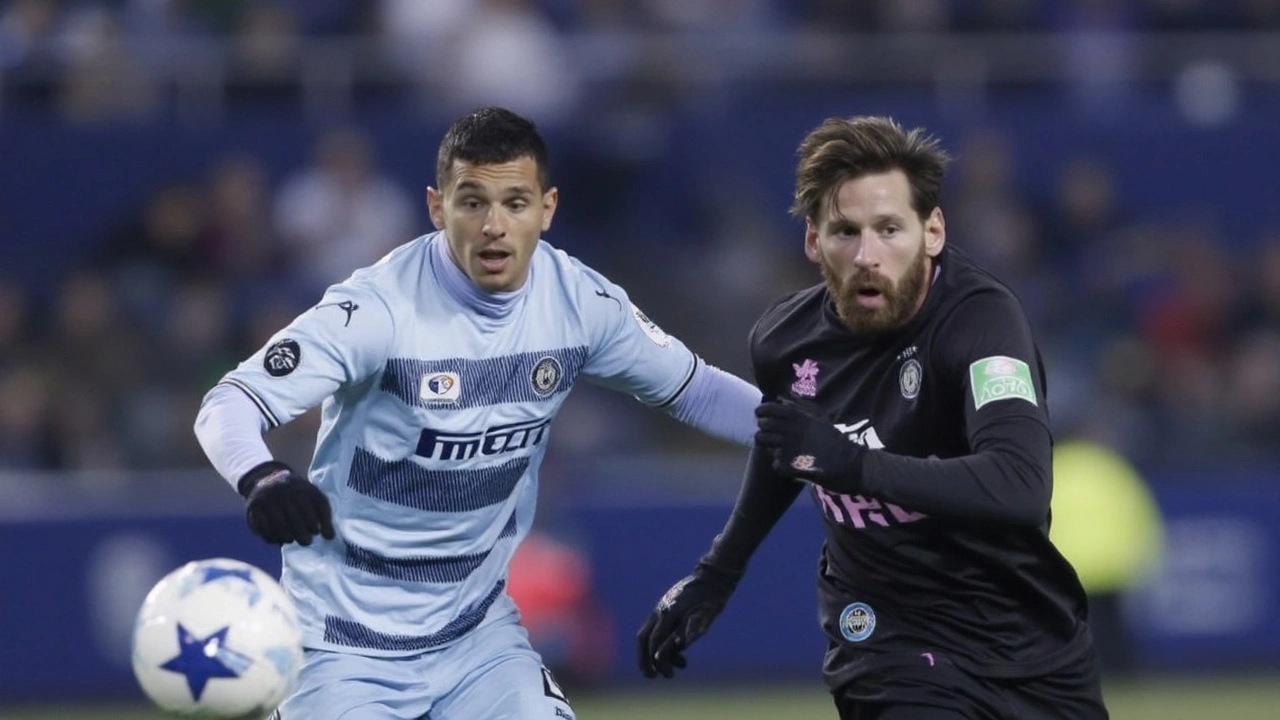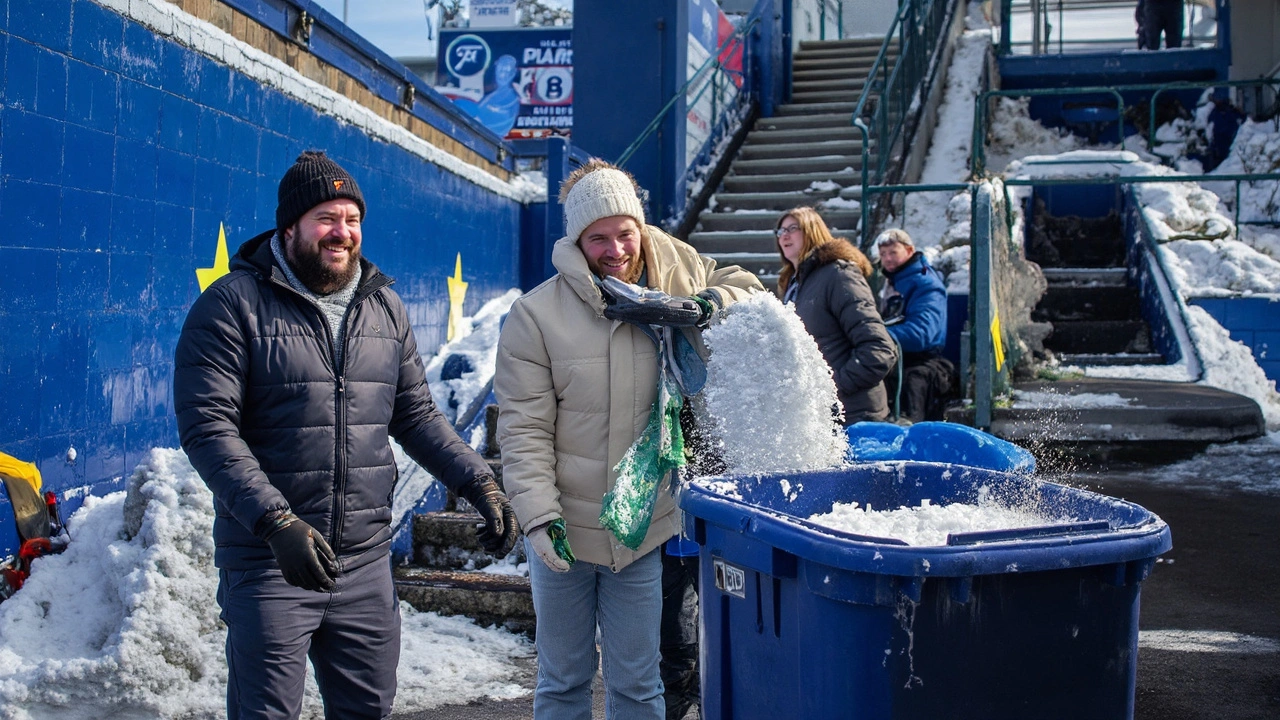Facing the Freeze: A Historical Match
In an unexpected twist for soccer enthusiasts, the clash between Sporting Kansas City and Inter Miami CF on February 20, 2025, has sent shivers down the spine of both players and fans alike. The Concacaf Champions League fixture faced a daunting forecast: windchill temperatures plummeting to a bone-chilling -20°F, potentially setting a new record for the coldest soccer game ever recorded. This event could overtake the previous mark set during a Siberian Premier League match in 2018, which had a windchill of -13°F.
Despite the harsh weather, the game carried on after an earlier postponement due to snow. Both teams emphasized player safety, aware of the risks associated with such extreme conditions. Sporting KC’s manager, Peter Vermes, communicated the importance of preparation, ensuring that his team was well-equipped to handle the icy conditions. The club took measures to accommodate fans enduring the cold, providing blankets, hand warmers, and advising attendees to use heaters as they braved the weather.

Messi's Resilience and Fan Adaptation
The spotlight naturally turned to Lionel Messi, Inter Miami's star player, known for his prowess on the field. Concerns over the impact of the cold on his performance were alleviated when coach Javier Mascherano confirmed Messi's participation. Despite potential health risks, Messi's determination was evident as he prepared to take on the challenge. Meanwhile, fans showed resilience, adjusting to the extreme temperatures by utilizing complimentary hand warmers and filling the stadium with extra layers.
Tickets to the match were priced at $25, acknowledging the poor weather conditions. Although the field had heating, it offered limited comfort to players grappling with the icy turf. The tight schedule of the league ruled out any further postponements, maintain the integrity of the competitive calendar. This decision, though a challenging one, underscored the commitment to pushing through adversities.
With this match being Messi's debut in MLS competition, anticipation and excitement were at an all-time high. His 56th-minute goal secured an initial lead for Inter Miami as they head into the second leg scheduled for February 25. In a game driven by determination and grit, the players demonstrated unwavering focus, despite the biting cold. Both teams continue to gear up for the next match with the same resolve, eager to progress further in the tournament.


Steve Dunkerley
February 20, 2025 AT 17:13Indeed, the thermodynamic challenges posed by a -20°F windchill demand a rigorous assessment of player physiology and equipment integrity. The synoptic analysis of the atmospheric conditions aligns with the logistical protocols established by the league's health and safety division. Moreover, the provision of thermally insulated blankets and exothermic hand warmers demonstrates a commendable mitigation strategy. Nonetheless, the biomechanical implications of reduced muscular elasticity in sub-zero environments merit further empirical scrutiny. In summary, the orchestrated response reflects an interdisciplinary coordination of sports medicine, engineering, and operational management.
Jasmine Hinds
March 5, 2025 AT 02:49Wow what a wild night of soccer love the fans braving the cold together :)
Madison Neal
March 17, 2025 AT 12:25I totally feel the players' perspective when you mention muscular elasticity – the cold can really impair contractile velocity. Your point on interdisciplinary coordination resonates; it's crucial that sports science and facility engineering sync their protocols. The extra thermal gear, while helpful, might still fall short of achieving optimal core temperature maintenance. It would be beneficial to see data on injury incidence from comparable hypothermic matches.
John Crulz
March 29, 2025 AT 22:01That turn of events definitely sparked a lot of talk among the fanbases. I was curious about how the league's scheduling flexibility could accommodate such extreme weather, especially with the tight timeline. The decision to keep the match on schedule shows a strong commitment but also raises safety questions. From a logistical standpoint, the heated field patches and stadium heaters are clever, yet they might not offset the ambient chill entirely. Players' acclimatization routines probably included extra warm‑up drills. Overall, it’s a fascinating case study in balancing competition integrity with athlete welfare.
Anita Drake
April 11, 2025 AT 08:37Indeed, the balance between preserving the cultural spectacle of the game and ensuring participant safety is a delicate one. Diverse fan experiences, from local supporters to international viewers, shape how such events are perceived. By offering inclusive amenities like blankets and hand warmers, the club demonstrates cultural sensitivity. Still, continuous dialogue with medical experts could further enhance the inclusive approach.
Eduardo Lopez
April 23, 2025 AT 18:13It is downright reprehensible that any entity would trivialize the sheer physical torment inflicted upon athletes in sub‑zero conditions. The romanticization of 'toughing it out' reflects a disturbing moral complacency within the sporting establishment. Spectators should not be glorifying suffering as theatrical entertainment. The league's insistence on proceeding, despite clear physiological hazards, is an affront to basic human decency. Fans demand accountability, not just a nostalgic narrative of grit. Moreover, the commodification of such peril for viewership ratings borders on exploitation. It is incumbent upon governing bodies to prioritize health over spectacle. The conversation must shift toward humane scheduling practices.
Nancy Perez de Lezama
May 6, 2025 AT 03:49I understand your concerns, but I think the article perhaps overstates the danger. The measures taken were reasonable and the players are professionals. It's likely that the risk was manageable.
Matt Heitz
May 18, 2025 AT 13:25When evaluating the sociopolitical ramifications of hosting a marquee match under such excruciatingly low temperatures, one must consider the broader narrative of American resilience versus imported European complacency. The decision to press onward showcases the United States' inherent fortitude, a hallmark of our national character that refuses to cede to foreign sensibilities about comfort. Critics who lament the harshness fail to recognize that the very essence of competitive sport is to test limits, both physical and psychological, thereby reinforcing a cultural ethos of perseverance. Moreover, the integration of a global icon like Messi into the MLS framework serves as a symbolic convergence of international talent and American ambition, cultivating a hybrid identity. The logistical deployment of thermal field technology and auxiliary heating apparatus illustrates an exemplary application of domestic engineering prowess. Yet, the underlying message extends beyond mere temperature control; it signals an unapologetic commitment to maintaining the integrity of the competition schedule, a principle that many foreign leagues might abandon for player convenience. By confronting a -20°F windchill head‑on, the clubs demonstrate to the world that American soccer can thrive under adversity, thereby bolstering the sport’s domestic market share. The economic implications are non‑trivial, as broadcast ratings surge when narratives of extreme endurance capture public imagination. In addition, the fan engagement strategy-blankets, hand warmers, and community outreach-reinforces a grassroots solidarity that fortifies local support. It also underscores the strategic deployment of soft power, projecting an image of inclusive hospitality despite the climatic adversity. Detractors who label the event reckless ignore the rigorous risk assessments performed by certified medical professionals, whose protocols align with the national standards set by the U.S. Soccer Federation. The physiological data amassed from this event will likely inform future best‑practice guidelines, enhancing player safety across the league. Furthermore, the competitive outcomes, including Messi’s early scoring, provide empirical evidence that elite performance can be sustained even in hypothermic environments when proper preparation is observed. From a broader perspective, this match serves as a case study in the intersection of climate adaptation and sports management, offering valuable insights for policymakers confronting similar challenges. Ultimately, the narrative reaffirms a quintessentially American doctrine: perseverance through hardship, collaboration across sectors, and an unwavering dedication to the spectacle of sport, regardless of the temperature.
Susan Mark
May 30, 2025 AT 23:01That's an intriguing take on the nationalistic aspects of the event. From a sports‑science viewpoint, it's worth noting that the players' core temperatures were monitored continuously, which mitigated many of the hypothermic risks you mention. The community initiatives you highlighted indeed fostered a sense of unity, though some fans reported mild frostbite despite the precautions. Overall, the blend of engineering, medical oversight, and fan engagement created a multifaceted safety net.
Jason Jennings
June 12, 2025 AT 08:37Honestly, the whole thing felt like a publicity stunt more than a genuine competition. The league's cheap ticket price didn't make up for the miserable cold. It's just another example of American sports overreaching to prove a point.
Diego Vargas
June 24, 2025 AT 18:13i get where you're coming from but the data shows low injury rates in these conditions. the league followed standard protocols so it's not just a stunt.